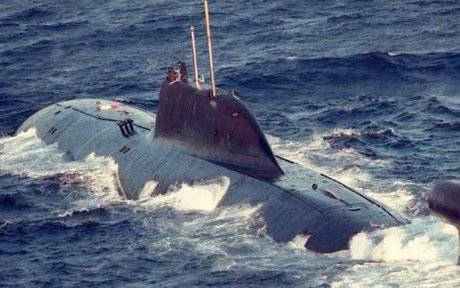From the courtroom to the sea
 The other day pacific naval the military court put an end to the case of the accident that occurred on the Nerpa nuclear submarine (NPS) K-152. The commander of the guard submarine, Captain 1st Rank Dmitry Lavrentyev and the bilge engineer Dmitry Grobov, was finally convicted.
The other day pacific naval the military court put an end to the case of the accident that occurred on the Nerpa nuclear submarine (NPS) K-152. The commander of the guard submarine, Captain 1st Rank Dmitry Lavrentyev and the bilge engineer Dmitry Grobov, was finally convicted.Recall that the 8 of November 2008 of the year during the testing of the submarine “Nerpa” in the Sea of Japan occurred unauthorized inclusion of a bulk chemical fire extinguishing system, which caused the death of 20 people.
Guard captain 1-th rank Dmitry Lavrentiev was charged under part 3 Art. 286 of the Criminal Code of the Russian Federation. From the point of view of the prosecution, the commander of the Nerpa nuclear submarine did not ensure the proper degree of training of the personnel of the submarine, which was the cause of the serious consequences. Bilge driver, foreman of 1 article Dmitriy Grobov was accused under 3 Art. 109 of the Criminal Code of the Russian Federation.
According to the lawyer D.Lavrentyev Sergey Bondar, the acquittal was handed down by the jury and due to the fact that “the corpus delicti is not established”.
“The essence of the matter was as follows: the jury had to establish whether the fire extinguishing mixture was supplied precisely as a result of pressing the fire extinguishing system key,” explains S. Bondar. According to the lawyer, the jury was forced to admit that the filing of the mixture, which caused the death of people, was not provoked by the actions of the driver Dmitry Grobov.
Also, the court rejected about 30 claims for compensation of material and moral damage to D. Lavrentyev and D. Grobov by the victims. The cancellation of the subscription applied to the defendants was canceled.
Dmitry Lavrentiev admitted that he considers the sentence handed down by the court to be fair, objective and fully reflecting the actual state of affairs.
 Representatives of the state prosecution preferred to refrain from commenting, but Roman Kolbanov, an assistant to the military prosecutor of the Pacific Fleet, said that the state prosecutors were going to appeal the verdict in the military board of the Supreme Court. Also, many representatives of the victims did not agree with the verdict. According to Vladimir Nezhura, fitter, member of the transfer team, Alexander’s son, who was also a member of the transfer team, lost as a result of the accident, should have been found guilty and D. Lavrentyev, the ship’s commander, and D. Grobov, a bilge driver, who initially pleaded guilty .
Representatives of the state prosecution preferred to refrain from commenting, but Roman Kolbanov, an assistant to the military prosecutor of the Pacific Fleet, said that the state prosecutors were going to appeal the verdict in the military board of the Supreme Court. Also, many representatives of the victims did not agree with the verdict. According to Vladimir Nezhura, fitter, member of the transfer team, Alexander’s son, who was also a member of the transfer team, lost as a result of the accident, should have been found guilty and D. Lavrentyev, the ship’s commander, and D. Grobov, a bilge driver, who initially pleaded guilty .And in the opinion of attorney S. Bondar, the final point in the dispute between the defense and the state prosecution will not be put soon, and the intellectual confrontation will continue. The verdict passed by the jury is obligatory for both parties and, by law, leaves no reason for doubt in this decision. Also, the discussion of the verdict is not the responsibility of the court of cassation. The court will conduct the investigation if the prosecution submits relevant arguments on issues related to the violation of the procedure. According to the suggestion of attorney D. Lavrentyev, the court of cassation will most likely start to consider the case after about three months.
According to Mr. Lavrentyev, he legally continues to remain the commander of the submarine, the fact is that during the trial he was temporarily suspended from his duties. Therefore, D.Lavrentiev is now preparing to launch the ship at sea to prepare the transfer of the boat to India for rent. The deadlines for the transfer of the Nerpa's submarines to India have been postponed several times.
In addition to Lavrentiev and Grobov, the accident also related to the head of the chemical laboratory of the technical administration of the Pacific Fleet headquarters Andrei Dityatyev, who was recently convicted by the decision of the Vladivostok Garrison Military Court. He was found guilty of forgery of the results of the analysis of the 114ВХNUMX freon composition, which is used to extinguish fires on ships.
According to Sergey Bondar, the criminal case initiated against A. Dityatyev can be considered an echo of the accident on the submarine in 2008, the year. During the examination, results were obtained that showed that in the LOCH system, in addition to the 114B2 freon composition, which has a purity of 99,5%, there was an extraneous substance on the 64% that was quite inexpensive, but much more toxic tetrachlorethylene. At that moment, when the system was put into action, people began to lose consciousness immediately after the first breaths, fell, then died from asphyxiation caused by an acute lack of oxygen. After the accident on the submarine "Nerpa" on the Pacific Fleet, control over the quality of fire extinguishing equipment was tightened.
Information